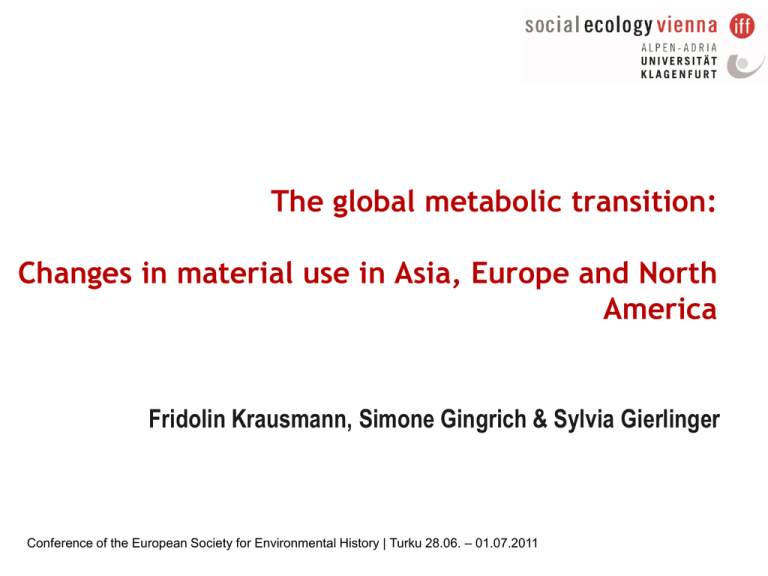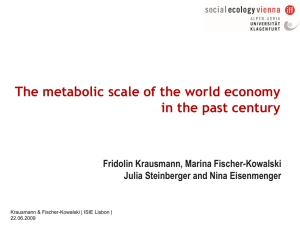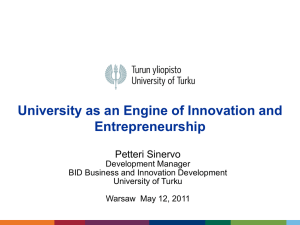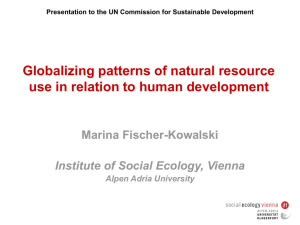Document
advertisement

The global metabolic transition: Changes in material use in Asia, Europe and North America Fridolin Krausmann, Simone Gingrich & Sylvia Gierlinger Conference of the European Society for Environmental History | Turku 28.06. – 01.07.2011 Overview • The metabolic transition • Material flow database • Global trends in material use • Material flows in UK, Japan and USA • Industrial vs. industrializing countries • Concluding remarks Krausmann et al.| ESEH Turku| 30.06.2011 The metabolic transition From tapping solar flows to... Non-agricultural population Agricultural population Production Land use Photosynthesis Energy flows Human labour Biomass Fossil Energy The metabolic transition ....to exploiting fossil stocks Urban-industr. population Production Agricultural population Land use Photosynthesis Fossil energy Energy flows Human labour Biomass Fossil Energy The metabolic transition The hypothesis of the metabolic transition is derived from historical evidence and claims that industrialization is related to fundamental and characteristic changes in the structure and size of social metabolism: – The transformation of the energy system: from solar based and land related (food, feed, wood) to fossil fuel based; from tapping flows to exploiting stocks – Changing relation of land use and energy: agriculture changes from an „energy source“ to a sink of energy – Absolute growth of population, material and energy use – Relative (per capita) growth of material and energy use – Characteristic metabolic profiles of agrarian and industrial socioecological regimes Krausmann et al.| ESEH Turku| 30.06.2011 Material flow database • Material Flow Accounting (MFA); based on Eurostat 2009 and OECD 2008. Advancements for historical application • Flows: – Used extraction of materials, – Imports and Exports – The database distinguishes ca. 60 material groups at the most detailed level; all flows in [t/yr]; • Regions and time period covered: – 175 countries in 10 year intervals from 1950 to present – 60 countries in annual resolution from 1970 to present – UK, USA, Japan, World in annual resolution from 1850/1900 to present • Data sources: National and international statistical sources; models to estimate and crosscheck flows of specific materials Krausmann et al.| ESEH Turku| 30.06.2011 Material flow accounting (MFA) Material group Subgroups Biomass Crops; used crop residues; wood; hay and grazed biomass; fish catch,… Fossil energy carriers Coal; petroleum; natural gas; peat Ores and industrial minerals Iron and non-iron ores; sand and caly, fertilizer minerals,….. Construction minerals Sand, gravel and crushed stone; clay; dimension stone,…. MFA derived Indicators: • Domestic Extraction of raw materials • Imports and exports of raw materials, semimanufactured and manufactures products • Domestic Material Consumption (DMC) = Domestic Extraction + Imports – Exports • Physical Trade Balance (PTB) = Imports - Exports Krausmann et al. ESEH Turku | 30.06.2011 Global trends in material use, 1900-2005 Material use (DMC) Material and energy use per capita 60 100% 100,0 Construction minerals Ores and industrial minerals Fossil energy carriers Biomass 80,0 Oil price shocks TPES [GJ/cap/yr] [billion tons] 40 60% 40% WEC 20 WWII DMC/cap (secondary yaxis) 8,0 Material/cap/yr 60,0 6,0 40,0 4,0 Energy/cap/yr Construction minerals 20% 20,0 Ores and industrial minerals 2,0 Fossil energy carriers Biomass Krausmann et al.| ESEH Turku| 30.06.2011 - - 1900 1905 1910 1915 1920 1925 1930 1935 1940 1945 1950 1955 1960 1965 1970 1975 1980 1985 1990 1995 2000 2005 2005 2005 2000 2000 1995 1995 1990 1990 1985 1985 1980 1980 1975 1975 1965 1965 1970 1970 1955 1955 1960 1960 1945 1945 1950 1950 1900 1900 1905 1905 1910 1910 1915 1915 1920 1920 1925 1925 1930 1930 1935 1935 1940 1940 0% 0 DMC [t/cap/yr] 80% 10,0 TPES/cap (primary yaxis) Material use, population and GDP Metabolic Rate: Material use per capita Mineral/fossil Material Intensity: Material use per GDP Biomass Biomass Mineral/fossil Krausmann et al.| ESEH Turku| 30.06.2011 UK, USA and Japan: Three leading economies • United Kingdom (UK): Starting point of the industrial revolution; leading economy of the 18th and 19th century • United States (USA): New World; overtakes the UK as the leading economy around 1900. Largest economy of the 20th century • Japan (J): Late comer; rapid industrialization process after WWII • The three countries produce 30% of the global GDP in 2005 Income [GDP/cap/yr] USA UK Japan Based on Maddison 2008 Krausmann et al.| ESEH Turku| 30.06.2011 Development of DMC, 1852/70-2005 United Kingdom USA Japan 1973 1973 1973 1917 1929 1941 Sources: UK: Based on Schandl/Schulz 2002 & Eurostat 2009 USA: Gierlinger/Krausmann 2011 Japan: Krausmann/Gingrich/Nourbach-Sabeth 2011 Krausmann et al.| ESEH Turku| 30.06.2011 Development of DMC, 1852/70-2005 Metabolic rate: DMC/cap/yr United Kingdom Sources: UK: Based on Schandl/Schulz 2002 & Eurostat 2009 USA: Gierlinger/Krausmann 2011 Japan: Krausmann/Gingrich/Nourbach-Sabeth 2011 Krausmann et al.| ESEH Turku| 30.06.2011 USA Japan Physical trade balance 1852/70-2005: negative: net exports; positive: net imports United Kingdom Sources: UK: Based on Schandl/Schulz 2002 & Eurostat 2009 USA: Gierlinger/Krausmann 2011 Japan: Krausmann/Gingrich/Nourbach-Sabeth 2011 Krausmann et al.| ESEH Turku| 30.06.2011 USA Japan Material intensity: DMC/GDP DMCtotal per GDP DMCminerals/fossils per GDP 1918 USA 1881 1973 UK Japan Krausmann et al.| ESEH Turku| 30.06.2011 Global significance of UK, USA and Japan Krausmann et al.| ESEH Turku| 30.06.2011 Growing Giants: Material use in India Material use (DMC) Source: India: Singh et al. 2011 Krausmann et al.| ESEH Turku| 30.06.2011 Material use (DMC/cap/yr) Concluding remarks • The metabolic transition entails a shift from biomass towards fossil and mineral resources. Biomass use is linked to population; fossil and mineral materials to GDP • The emerging industrial metabolism did not replace the agrarian metabolism, but added on top of it. • Materialization of the economy can be a very fast process; dematerialization is a slow process. • Periods in which infrastructures and large industries are built up are crucial for the development of the industrial metabolic pattern. These structures impose important legacies for long term development. Krausmann et al.| ESEH Turku| 30.06.2011 • Data available for download: http://www.uni-klu.ac.at/socec/inhalt/1088.htm • Publications: – Krausmann, F. (Ed.). 2011. The global metabolic transition. Long term historical trends and patterns in global material and energy use. Social Ecology Working Paper 131. Inst. of Social Ecology, Vienna: http://www.uniklu.ac.at/socec/eng/inhalt/338.htm – Krausmann, F., Gingrich, S., Eisenmenger, N., Erb, K.H., Haberl, H., FischerKowalski, M. 2009. Growth in global materials use, GDP and population during the 20th century, Ecological Economics 68 (10). 2696-2705. – Krausmann, F., Gingrich, S., Nourbakhch-Sabet, R., 2011. The metabolic transition in Japan: A material flow account for the period 1878 to 2005. Journal of Industrial Ecology (in print). – Gierlinger, S. and Krausmann, F., 2011. The physical economy of the United States of America: Extraction, trade and consumption of materials from 1870 to 2005. Journal of Industrial Ecology (in print). Krausmann et al.| ESEH Turku| 30.06.2011 Thank you for your attention! Krausmann et al. ESEH Turku | 30.06.2011









